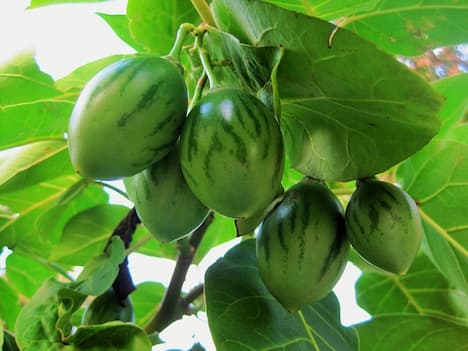Tamarillo (Solanum betaceum Cav. syn. Cyphomandra betacea Sendt.) is a highly nutritious egg-shaped fruit with red, purple-red, yellow, golden, or orange skin when ripe and depending on the variety grown. Usually, unripe fruits are green in color but maybe inedible at this stage due to their unbearably tart taste. In this article, we will explore the benefits of tree tomato (tamarillo) fruit, its uses, and taste.

Where Does Tree Tomato Grow Today?
Tamarillo grows in different parts of the world but is native to the Andes Mountains that stretch across Bolivia, Ecuador, Argentina, Colombia, Chile, and Peru. It remains a popular fruit in these countries to date. However, it has become increasingly common in regions with subtropical climates, such as New Zealand, Australia, South Africa, the United States, Kenya, and China. This fruit belongs to the Solanaceae (nightshade) family, alongside potatoes, pepper, tomatillo, Pepino melons, naranjilla, goji berry, and tomatoes.
What is the Difference Between Tree Tomato Fruit and Tomatoes?
The name of this fruit varies across regions. Tamarillo is referred as tree tomato in specific countries, owing to its close resemblance to a tomato. However, it grows on a tree instead of a vine, as is the case for ordinary tomatoes. Some people also use “blood fruit” to refer to the red tamarillo. By contrast, Indonesians locally call this fruit terong Belanda, which translates to Dutch eggplant.

Amazing Benefits of Tamarillo (Tree Tomato)
Tamarillos are a nutritional powerhouse with high vitamin, antioxidant, mineral, and dietary fiber content. These nutrients contribute to the many health benefits of tree tomato fruits. As noted, tamarillos have high iron, magnesium, copper, and potassium content. They further supply the body with zinc, calcium, and phosphorus. These fruits also contain vitamin C, vitamin A, thiamine (vitamin B1), riboflavin (vitamin B2), niacin (vitamin B3), vitamin K, and pyridoxine (vitamin B6).
Tamarillo has anti-obesity properties
Obesity is a pressing concern across all populations and a significant source of disease today. It often occurs due to the intake of a high-fat diet. However, research shows that tamarillo fruits have protective effects against excessive weight gain.
Tree tomato provides this benefit because of its high levels of phytochemicals, dietary fiber, and micronutrients. For instance, this fruit has a high vitamin content, along with flavonols, anthocyanins, beta carotene, ascorbic acid, and phenolic acids. These bioactive compounds neutralize reactive oxygen species and alleviate oxidative stress.
The low energy density and high water content in these fruits also contribute to their anti-obesity properties. In addition, the viscous dietary fiber in tamarillo helps improve postprandial satiety and reduce hunger.
Tamarillo reduces cardiovascular disease risk
Generally, tamarillo fruits have high antioxidant activity. They specifically have high ascorbic acid, α-tocopherol, and carotenoid (β-carotene, lutein, zeaxanthin, β-cryptoxanthin, and antheraxanthin) concentrations. Usually, the purple-red variety has a significantly high content of β-carotene, vitamin C, and α-tocopherol than other cultivars.
Carotenoids have strong antioxidant properties and often play a critical role in preventing cardiovascular diseases. β-carotene particularly has protective effects against inflammation, apoptosis, oxidative stress, and hepatic steatosis, enabling it to fight chronic conditions.
Vitamin E in the form of α-tocopherol also helps prevent atherosclerosis (plaque buildup) owing to its high antioxidant activity. As a result, there is evidence that α-tocopherol in tamarillo can reduce heart disease risk. In any case, studies show that this form of vitamin E assists in treating and preventing the different chronic illnesses linked to oxidative stress.
Tamarillo protects against cancer
The different phenolic compounds and anthocyanins found in tamarillo fruits have potent antioxidant activity. They generally confer protective benefits against free radicals, which play a significant role in cancer development. For instance, flavanols have anticancer properties. Catechin, specifically, inhibits cancer cell formation in healthy people. Therefore, their antioxidant power helps minimize cancer risk in the general population.
Evidence also suggests that tamarillo extracts have powerful cytotoxic effects. Studies reveal that these extracts have enough power against breast and liver cancer cells as doxorubicin, a commercially available anticancer drug.
Tamarillos further contain lutein and zeaxanthin, two common carotenoids known to prevent certain types of cancers. In addition, these fruits have β-carotene and β-cryptoxanthin. These carotenoids also contribute to cancer prevention by eradicating free radicals and limiting oxidative stress throughout the body.
Tamarillo improves eyesight and promotes eye health
The lutein and zeaxanthin in tamarillo fruits play a crucial role in promoting eye health and boosting eyesight. These pigments specifically build up in the eye lens and retina and help to block the sun naturally. They usually absorb the excess light and keep the eyes safe against harmful blue light.
Tamarillo also boosts eye health in people with cataracts and macular degeneration. Evidence shows that taking lutein and zeaxanthin in high concentrations reduces cataracts by more than 20%. A high intake of these pigments also decreases macular degeneration by over 40%, demonstrating eating tamarillos leads to better eye health outcomes.
Tamarillo prevents and treats anemia
Iron is vital in ensuring an adequate supply of healthy red blood cells. Lacking sufficient iron in the body often contributes to iron deficiency anemia. However, taking tamarillo helps manage this problem or prevents its onset because this fruit is a rich source of iron. In particular, the high iron content ensures the body produces sufficient red blood cells, fighting anemia risk.
In addition, the vitamin C in tamarillo aids in preventing iron deficiency anemia by increasing iron absorption. Tamarillo is also likely to avert vitamin deficiency anemia because it is a good source of vitamin C.
Tamarillo is good for diabetes
Generally, tamarillo fruits benefit people with diabetes because they have a low glycemic index. As a result, diabetic patients can safely take them as part of the diet without spiking their blood sugar levels.
Tamarillos also provide a significant amount of antioxidants that play a critical role in reducing oxidative stress and managing blood sugar levels in persons with diabetes. For instance, these fruits contain vitamin E. According to current evidence, vitamin E significantly reduces blood glucose, including glycated hemoglobin, due to its potent antioxidant properties.
Vitamin C, another nutritional component of tamarillos, further helps with blood glucose management by promoting insulin synthesis and secretion and alleviating insulin resistance.
In addition, these fruits contain chlorogenic acid. This polyphenol facilitates blood glucose regulation if added to the diet. Evidence shows that it decreases glycated hemoglobin, fasting plasma glucose, and visceral fat contents. As a result, the chlorogenic acid in tamarillos promotes diabetes management and prevents related complications.
Tamarillo is good for the skin
Tree tomato is a fitting addition to a daily diet for persons desiring healthy skin. Its skin benefits come from vitamins A, C, and E in this fruit. In addition, tamarillos supply phenolic compounds, anthocyanins, and flavonoids, which contribute to youthful skin. The antioxidant effects of these phytochemicals prevent skin damage and promote its healing and restoration.
Tamarillo helps regulate blood pressure
As noted earlier, tamarillo is rich in potassium. This mineral assists in blood pressure regulation in two main ways. First, it supports blood vessel function, easing blood circulation and lowering blood pressure. Secondly, taking sufficient potassium promotes the removal of excess sodium in the body, promoting blood pressure management.
Uses of Tamarillo/Tree Tomato
Most people eat tree tomato by halving a ripe fruit and scooping its flesh and dark seeds with a spoon. However, this fruit finds use as a healthy addition to salads and smoothies. It also helps manufacture jams, jellies, chutneys, sauces, or compotes due to its high pectin levels. Tamarillo can be eaten in cooked or roasted form. It is sometimes stewed or used to make soups. In addition, this fruit serves as a breakfast dish if sprinkled lightly with sugar and chilled. Some people also eat tamarillo with ice cream, pies, sandwiches, and puddings.
How Does a Tree Tomato Fruit Taste?
A tamarillo fruit has a unique aroma with a slightly bitter, sour, and astringent taste and a hint of sweetness. Its flavor is bold and complex, with the pulpy flesh around the fruit’s skin contributing to the bitter taste.
Orange and yellow tamarillos have a sweeter flavor, while the red cultivars have a more tart or sour taste. Even so, most people prefer the red tree tomato variety because of their appealing red color. The flesh of a tamarillo fruit may be orange, yellow, or orange-red, with dark seeds. This color depends on the variety.
Wow, very informative. Thank you